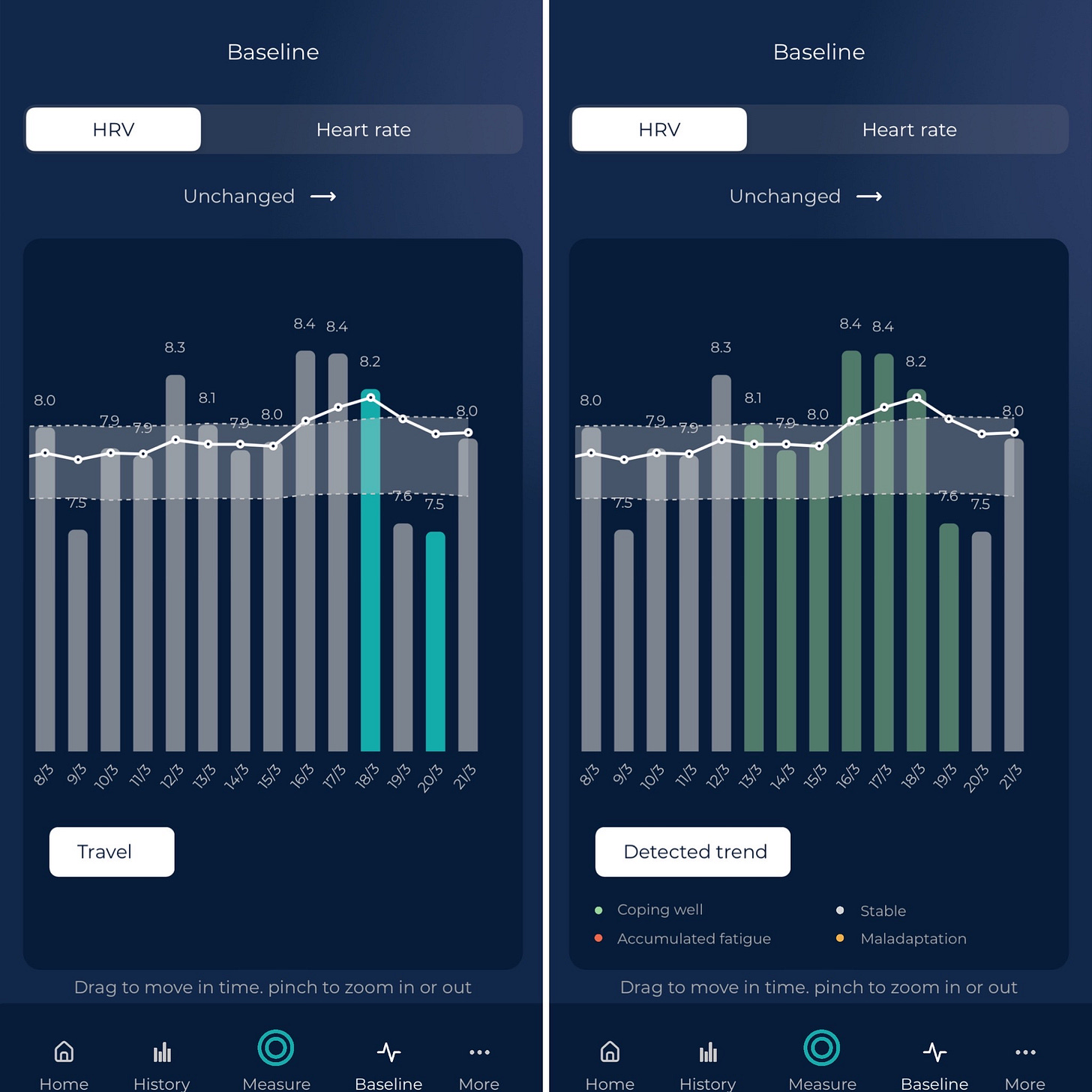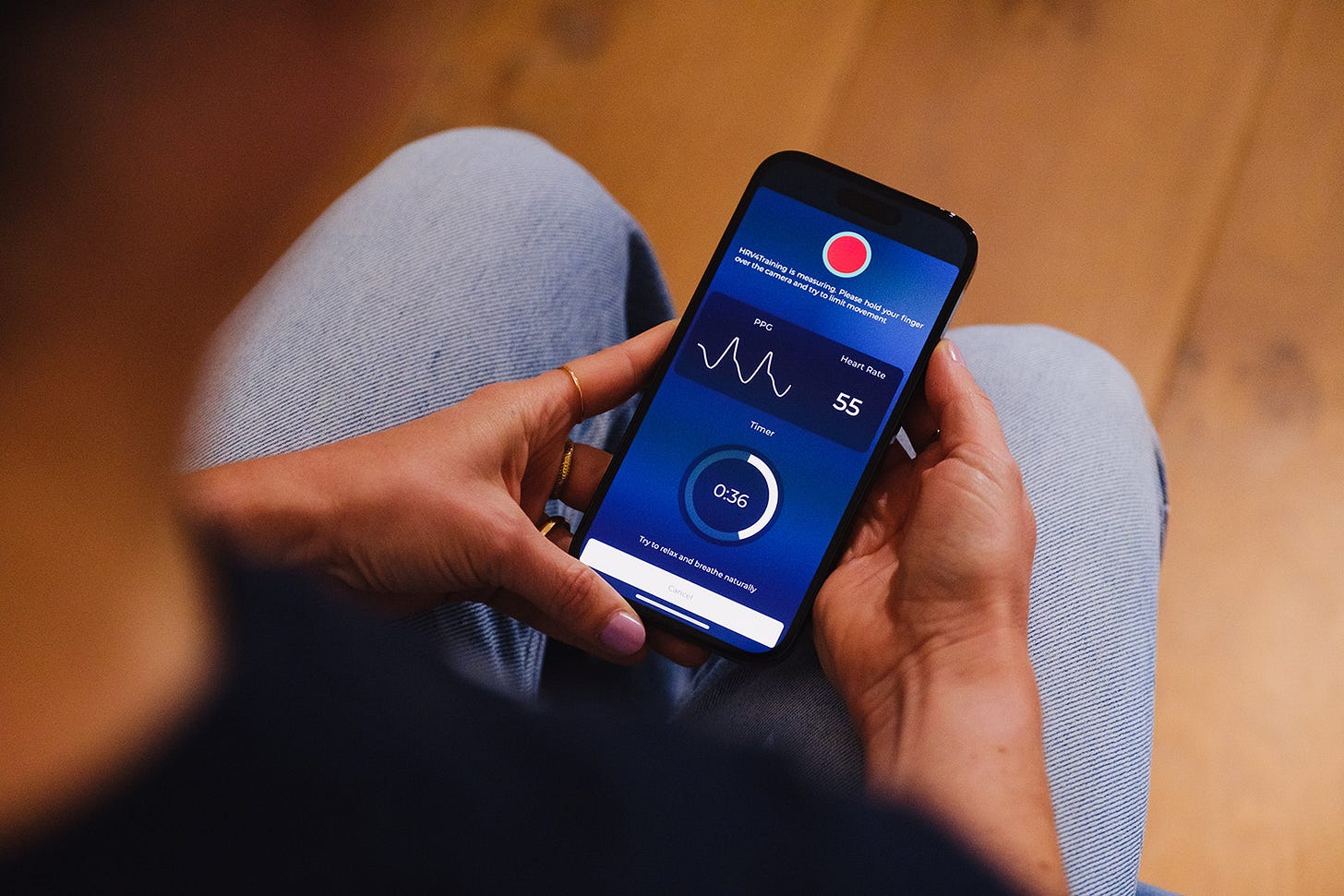Week 42: VO2 max, heart rate and HRV
hi there 👋
I hope everything is well.
In today’s newsletter, I discuss aspects related to VO2 max and its relationship with resting physiology measures such as heart rate and HRV, which - I believe - are often misunderstood.
Years ago, during my PhD studies, I worked on developing machine learning models to estimate cardiorespiratory fitness level (VO2max) from sub-maximal exercise data, typically collected in daily life, without any specific lab protocol. The basic principle is similar to what has been used in the following years by companies like Apple or Fitbit for their VO2max estimates (see some of my work from almost ten years ago, here).
Why am I telling you this?
During those years and also later on when adding VO2 max estimates to HRV4Training - in this case using exercise data e.g. collected via Strava - it was obvious when building and validating these machine learning models that HRV wasn’t of much use. I mean that heart rate alone was a much better predictor and even resting heart rate showed a stronger correlation with VO2 max than HRV (and also, adding HRV on top of resting heart rate, would not add anything).
As I am in the process of writing a book (more on this soon!), I have been thinking more about the relationship between cardiorespiratory fitness (VO2 max), heart rate, and HRV, and in particular about some of the mechanisms that might explain these differences in the usefulness of one metric or the other, in the context of estimating fitness. These differences and mechanisms are important because they allow us to use these metrics properly and avoid common misconceptions (e.g. thinking that a low heart rate as we age is a sign of ‘youth’ or better biological age, which is not the case).
What are these mechanisms then?
I think that part of the difference between heart rate and HRV in this context is due to how changes in fitness impact some metrics directly (i.e. heart rate) and some metrics indirectly (i.e. HRV), therefore having a smaller impact on the second one.
First, the connection between cardiorespiratory fitness, measured by VO2 max, and heart rate is well-understood. With consistent training, the heart becomes more efficient. The left ventricle, in particular, adapts to pump more blood per beat, increasing stroke volume. As a result, the heart doesn’t need to work as hard to deliver the same amount of oxygen to the muscles at any given intensity, which explains why both resting heart rate and submaximal heart rates drop as fitness improves. This is a straightforward adaptation — as stroke volume increases, heart rate decreases. This is what I’d call a direct link which makes the relationship between heart rate and VO2max quite strong (obviously, there is only so much that resting heart rate can estimate, but still, the link is obvious and the relationship can be easily seen across a diverse population).
What about HRV?
The link between fitness and HRV is less direct and more complex.
One of the key mechanisms that link stroke volume to HRV is the baroreflex. As stroke volume increases, particularly in well-trained athletes, the heart pumps more blood with each beat, raising blood pressure. This activates the baroreflex, which works to regulate blood pressure by stimulating parasympathetic activity (the baroreflex makes sure blood pressure stays where it should stay, by e.g. increasing heart rate if blood pressure is low, or reducing heart rate if blood pressure is high - it does so via the autonomic nervous system). As the body adapts to higher stroke volumes, parasympathetic activity increases, which in turn raises HRV. So, while HRV might not change directly due to improved fitness, it is influenced by the physiological changes that come with improved stroke volume, due to the baroreflex (at least in part). Additionally, plasma volume also increases with training, which enhances venous return and further boosts stroke volume. This increased plasma volume also stimulates the baroreflex, promoting higher parasympathetic activity and, therefore, higher HRV. Even though high training loads create significant stress, the body’s improved ability to manage this stress allows HRV to remain stable or even increase a little. This is what I would call and indirect link between a change in VO2max and a change in HRV. And indeed in studies in which we can elicit a larger change in VO2 max, e.g. in untrained individuals, typically we see also a change in HRV (rMSSD) together with improved fitness. An important final point here is that the reduction in heart rate itself can drive changes in HRV, given that with a lower heart rate, there is more room for variability (another indirect change in HRV).
We need also to keep in mind that HRV - unlike heart rate - has a relatively strong relationship with aging, and therefore values tend to decrease across decades even for physically active individuals. On the other hand, heart rate does not seem to reflect aging, and therefore the same heart rate can be seen in individuals decades apart, given a certain physical activity level (something we have observed in our research, published here).

HRV (when measured according to best practices), reflects heart rhythm modulation due to the autonomic nervous system, particularly parasympathetic activity, and is influenced by a wide range of factors beyond just physical fitness — things like recovery, stress, and even emotional or environmental conditions. All of these factors impact heart rate as well, which remains however more closely - or directly - tied to cardiorespiratory fitness, while HRV is influenced only indirectly. Based on the above, structural changes in the heart make it so that heart rate is reduced, while HRV mostly changes because of the baroreflex and increased parasympathetic modulation. This is why we often don’t see as strong a correlation between VO2 max and HRV — they reflect different aspects of the body’s response to training.
These are some of the reasons why I do not think we should use HRV as an outcome variable, aiming for an increase in HRV e.g. in a study, or when starting a physical activity program, or else - but we should use HRV for what it can do best: giving us a broader picture of how well the body is managing and responding to stressors, both from training and daily life. To do so, we look at relative changes with respect to our normal range, as we report in HRV4Training.

In summary, while heart rate responds directly to changes in stroke volume and fitness, HRV is influenced by broader physiological adaptations via the baroreflex. Over a lifetime, aging will also impact HRV - possibly as a sign of deterioration of underlying regulatory mechanisms - which is not reflected in resting heart rate - a parameter that remains a marker of our physical activity level as we age. Additionally, these relationships are visible when looking at data from a large, diverse population, but not necessarily obvious when analyzing individual data over time. Especially for fit individuals, relative changes tend to be associated with things other than cardiorespiratory fitness, even for heart rate (e.g. training load, seasonality, diet and other stressors).
Or at least, these are some of my thoughts on these mechanisms right now.
Ambassador Program 2025
Applications to become HRV4Training ambassadors for next year are still open. You can learn more and apply, here.
Discount for Pro: 20% off 🖥️
HRV4Training Pro is the ultimate platform to help you analyze and interpret your physiological data, for individuals and teams.
You can find a guide here.
Try HRV4Training Pro for free at HRVTraining.web.app or use promo code SCIENCE for 20% off.
In the app, Pro brings the normal values view, which can help contextualizing longer-term changes, as well as rMSSD on the homepage, see an example below:

See you next week!
Marco holds a PhD cum laude in applied machine learning, a M.Sc. cum laude in computer science engineering, and a M.Sc. cum laude in human movement sciences and high-performance coaching.
He has published more than 50 papers and patents at the intersection between physiology, health, technology, and human performance.
He is co-founder of HRV4Training, advisor at Oura, guest lecturer at VU Amsterdam, and editor for IEEE Pervasive Computing Magazine. He loves running.
Social:






If I am understanding correctly, this is a good reminder that we (I) shouldn’t expect HRV to “go up” as a measure of success during recovery periods, or as an indicator that fitness is improving. Thanks, Marco 🙏
Another easy to follow and informative read :)